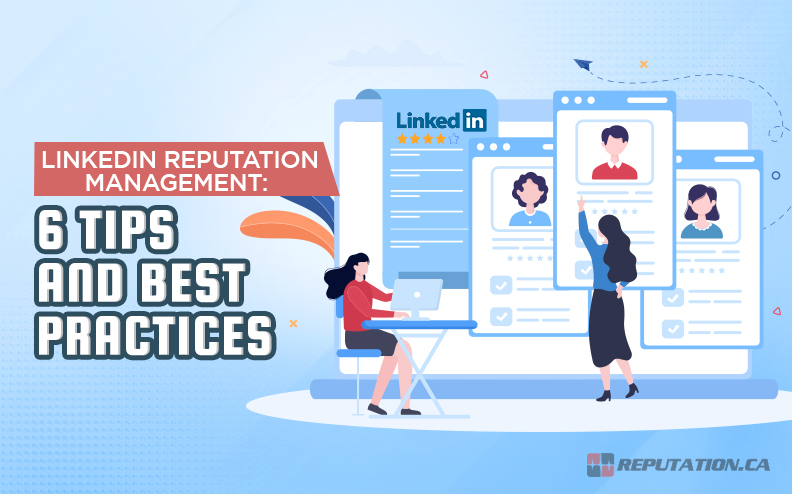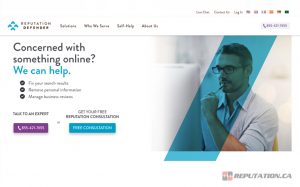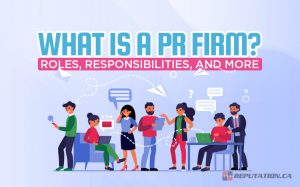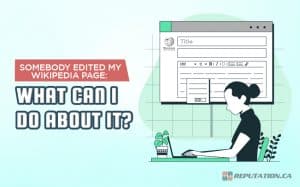Professional communication is critical in modern society since it allows professionals to interact with potential employers and vice versa. Once upon a time, this communication was limited to submitting résumés and waiting for letters or phone calls from applicants or employers. Almost all hiring and professional discourse now occurs online to save time and energy that can be reinvested in other business areas.
This online discourse has enabled a new generation of hiring procedures that expedite the process for both parties. While this benefits the various companies that need to replenish their ranks, another important detail exists. LinkedIn is a website designed to offer a medium that professionals and employers can use to connect, but it also allows them to discuss their pasts with potential hires and employers.
Protecting your reputation as a business or a professional requires you to present a sense of experience and confidence. This can quickly fade if your last job or a previous employee has negative things to say about you. As a result, you must ensure your presence on LinkedIn focuses on your strengths and successes rather than any issues previous employees or employers have with you.
This can be difficult to manage since LinkedIn is, at its core, a social networking website for professionals. Nevertheless, there are tactics you can employ to ensure you present the most professional and effective image to your potential employers or employees.
Professionals from various industries are usually assigned specific tasks or projects to complete independently or within a small team. These projects are testaments to what that professional can accomplish through their own skills or via team dynamics. LinkedIn enables professionals to discuss their previous accomplishments on other projects (assuming it does not violate a previously signed non-disclosure agreement).
These posts demonstrate your aptitude for certain tasks (i.e., meeting deadlines and quotas) and how a future employer could harness that skill. Showing insight into your work abilities and ethics is an extremely important part of cultivating a professional reputation through LinkedIn and other media platforms.

The key to these posts is to avoid bragging and remain utterly faithful to the honest recounting of how the project was completed. For example, do not take credit for a breakthrough your teammate made that could make you look good. Additionally, do not diminish your role in how the project was completed. Finding a balance between taking credit where it is due without usurping your team’s efforts is critical.
If it was a solo project, focus on the skills you used to accomplish it and whether you met your deadline (especially if you finished ahead of schedule). Demonstrating your skillset and ability to complete projects will make you more appealing to prospective employers and effectively undermine any criticisms about your professional abilities.
Employer Tip #1: Be Forthcoming With Office Culture
While it might sound strange, one of the biggest dealbreakers for a professional is finding out the potential employer has a poor office culture. No one wants to work in an environment where they will be met with animosity and psychologically draining interoffice relationships. There are horror stories daily detailing a workplace conversation or workload taxing on the employee’s mental health with no compensation for the extra effort they put in.
They also detail the effects of being saddled with responsibility outside their normal job description with minimal benefits. When word gets out that a company does not accommodate the needs of its employees and takes them for granted, it sparks discord with current and potential employees. This discontent can impact your business’s reputation, drive off potential hires, and, in some cases, turn your consumers against you.

LinkedIn allows your current and former employees to comment on the workplace culture they experienced while working for you. This can generate a preconceived image of what it is like to work for you and cause potential hires to look elsewhere. While this can be detrimental, you can turn things to your advantage to regain potential employees’ confidence. Outlining the workplace culture you are cultivating in your offices can help give potential hires a sense of security about working for you.
If the culture you are trying to create is conducive to the needs and preferences of your desired employees, applications will be more forthcoming. However, it is crucial that you do not embellish the workplace culture you have because this could cause new hires to distrust you when they see the real situation. Ultimately, explaining the workplace culture you offer on LinkedIn can positively improve your reputation (especially if you offer in-office benefits like a stocked break room or gym).
Employee Tip #2: Create A Network
As much as we might hate to admit it, a large part of getting hired is establishing connections with people who already have a foot in the door. Networking has become an essential part of the job market, so you can find potential jobs through individuals in the field you want to work in. Making those connections can be extremely difficult, and not every connection is positive.
Therefore, aspiring professionals in any field must ensure their network is carefully managed to avoid associating with the wrong people. For example, having a professional reference from someone who recently came under legal scrutiny might backfire and damage your image. No company wants to hire someone who willingly associates with a criminal (especially since guilt by association is becoming a common trend in the professional and personal worlds).

One of the main selling points of LinkedIn is that it serves as a networking tool, allowing professionals to establish connections with existing employees and businesses. You can create connections with these professionals through previous employment or meeting them while out in the world. Once you have created these connections, you can “link” with them on LinkedIn and show potential employers you have this connection.
For example, if an aspiring programmer creates a strong connection with a senior developer employed by Microsoft, it shows the level of peers you have. This creates an equivalency in a potential employer’s mind that you can use to get extra leverage during the hiring process. This could put you ahead of other potential hires who might not have such strong connections. That said, connections are not always enough unless the connection comes from the business you are applying to. Otherwise, it boosts your LinkedIn reputation by showing that you have the acknowledgment of a peer.
Employer Tip #2: Outline Mission Statement
One thing potential employees hate is learning that the company they applied to does not align with their goals as professionals. There are dozens of companies in the same field that have different goals from one another. No one wants to work for a company that will force them to go against their ambitions and ideals, though some preferences cannot be accommodated in a professional setting.
Nevertheless, aspiring professionals like to know their potential employer’s long-term goals and how those goals align with those aforementioned ideals. Many companies and businesses attempt to make their mission statement visible to consumers and employees alike, but it is not always as clear as possible.

LinkedIn provides an opportunity to make certain aspects of your mission statement more accessible to potential hires. This helps potential applicants compare their goals with your company’s intentions so they can make an informed decision about whether they want to work with you. Additionally, outlining your mission statement can positively influence potential employees by clearing up any public misconceptions about your corporate mission statement.
Sometimes, public opinion is swayed by baseless commentary or assumptions made by those without direct experience with the company. Outlining your company’s mission statement on LinkedIn can correct any misconceptions about its mission statement. This can bring renewed interest from potential employees so you can effectively staff your workforce.
Part of LinkedIn reputation management is ensuring that you do not come across as someone ignorant of the field you are trying to enter. Most companies have a definitive list of qualifications they expect from their employees. Therefore, fielding applications from professionals who lack the qualifications they expect can become an annoyance.
Most applications are accompanied by résumés that detail an applicant’s qualifications, though occasionally without some of the extra skills and certifications they might have cultivated throughout their careers. LinkedIn is a valuable resource for aspiring professionals who need to outline their special qualifications. Many companies look for additional qualifications earned through independent certification programs. One of the main industries that look for special certifications is technology, but the concept applies to most major fields.

LinkedIn allows you to list your educational and professional history so potential employers can better understand your past experience. However, it can also be an excellent place to list your certifications and extra education that exceeds traditional learning. Outlining your certifications, supplementary experience, and associated dates will make you more appealing to potential employers. Insofar as your LinkedIn reputation is concerned, it works wonders for highlighting your professionalism and potential to learn new skills.
This promotes your reputation as an adaptive professional willing to learn more about your industry. This makes you more desirable to employers and shows your value, which can improve your prospects and lead to multiple employers competing over you.
Employer Tip #3: Avoid Ambiguity
One of the most frustrating phrases an aspiring professional can read on a job posting is “competitive salary.” While you might not like it, most professionals want a concrete idea of their potential salary once they accept a position. Professionals can be passionate about their work, but their main goal will be making a living to thrive in modern society.
Therefore, it is critical that an aspiring professional can identify a livable wage while applying for full-time careers. Otherwise, their jobs will leave them living paycheck-to-paycheck when they should be able to focus on their futures. Applying for a job only to discover they will be making just over the minimum wage for full-time professional work is disheartening to anyone.

If you are posting jobs on LinkedIn that require advanced education and years of experience for an applicant to qualify, posting a vague salary will drive away potential hires. Offering a competitive salary for the field is a worthwhile detail to mention for a potential hire, but making sure they understand what that means is more important.
Vague salary offers are counterintuitive to recruitment and negatively affect your general reputation as an employer. Once word gets out that you are disguising low salaries as “competitive,” fewer applicants will consider the positions you post. Therefore, your best bet is to ensure the positions you list on LinkedIn (or any job hosting site) contain a valid salary estimate that allows applicants to calculate whether the position suits their financial goals.
Take Your Reputation Back!
Professional networking is difficult but extremely rewarding since it provides an enhanced reputation. LinkedIn has made professional networking easier and opened the door for issues and misunderstandings. Both professionals and businesses must ensure their LinkedIn practices do not damage their reputations. These tips and practices will ensure any posts you make (as an employee or employer) maintain professionalism and quality. While your practices on LinkedIn are important to preserving your professional reputation, there is more you must consider. Maintaining a public image as a professional requires you to focus on all aspects of your online presence, which can overwhelm you if you have other responsibilities to fulfill.

We at Reputation know that protecting your reputation can be a struggle, and you might not have the time or resources to handle it personally. That is why we have dedicated ourselves to offering reputation management services designed to help professionals and companies create a better reputation for themselves. We offer several services to optimize your online presence (including social media like LinkedIn) to ensure your public image does not suffer. If you need to optimize your LinkedIn profile to enhance your reputation, we urge you to visit our website and take your reputation back!












